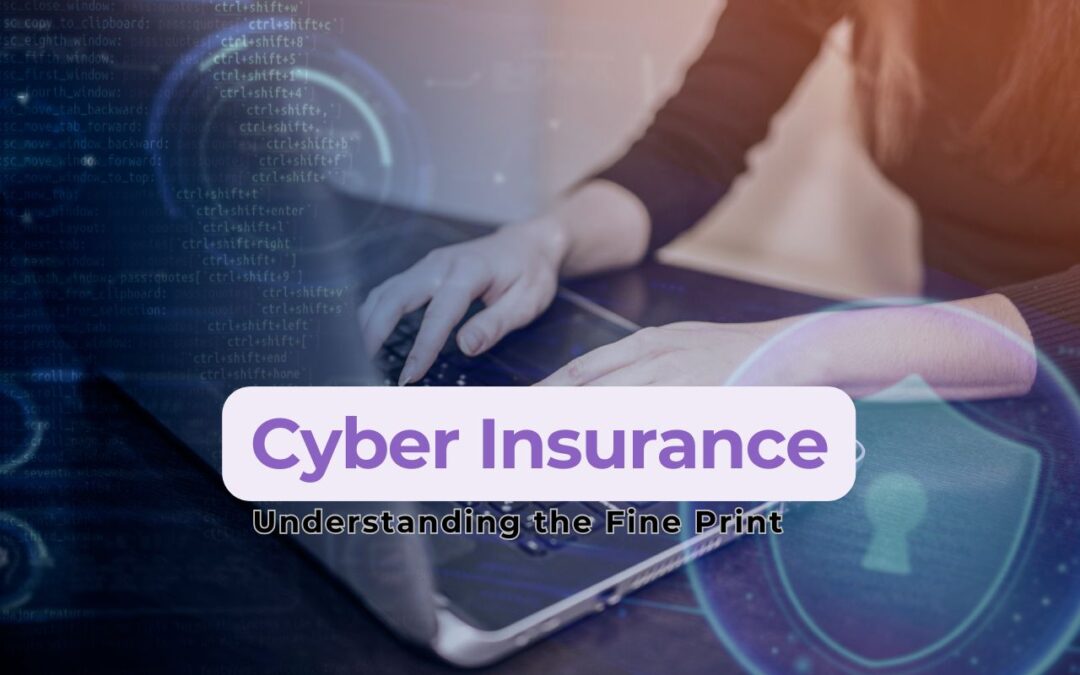In today’s hyperconnected business landscape, digital threats are not just lurking around the corner—they’re already inside the building. From small startups to global conglomerates, cyberattacks such as data breaches, ransomware, phishing, and denial-of-service (DoS) attacks have become increasingly prevalent. As businesses store more customer data and rely heavily on digital tools and cloud computing, the financial, legal, and reputational costs of cyber incidents have skyrocketed.
Enter cyber insurance: a rapidly evolving solution designed to mitigate the risks associated with cyber threats. But what does cyber insurance actually cover? More importantly, what doesn’t it cover? In this comprehensive guide, we will explore the intricate details of cyber insurance coverage, reveal what you need to look out for in the fine print, and provide insights to help you choose the right policy for your business.
1. What Is Cyber Insurance?
Cyber insurance, also known as cyber liability insurance, is a policy designed to protect businesses against the financial fallout of cyber incidents. These incidents could include malicious attacks, data leaks, system compromises, and even accidental data exposures. Cyber insurance provides both first-party and third-party coverages, meaning it can protect a business from direct losses as well as liabilities to others affected by a breach.
Unlike general liability insurance, cyber insurance specifically addresses risks related to information technology and digital assets, making it a critical component of a modern business risk management strategy.
2. Why Is Cyber Insurance Essential in Today’s Business Environment?
The digital transformation has changed the game for businesses. Here are some compelling reasons why cyber insurance is now indispensable:
- Increasing Frequency of Attacks: According to IBM’s 2024 Data Breach Report, the average organization experiences a data breach every 39 seconds.
- Rising Costs of Breaches: The global average cost of a data breach reached $4.45 million in 2024.
- Regulatory Pressure: Governments worldwide are implementing stricter data protection regulations (e.g., GDPR, CCPA, HIPAA), which can lead to heavy fines.
- Supply Chain Risks: Cyber risks now extend beyond internal networks to include third-party vendors, cloud service providers, and remote employees.
3. What Does Cyber Insurance Cover?
Coverage varies depending on the insurer, the industry, and the policy type. However, most standard cyber insurance policies include the following areas:
A. First-Party Coverage
These cover damages directly suffered by the policyholder.
i. Data Breach Response
- Forensic Investigations: Costs of identifying the source and scope of a breach.
- Legal Counsel: Legal fees to determine notification obligations.
- Customer Notification: Expenses related to notifying affected parties.
- Credit Monitoring Services: Costs to provide credit or identity monitoring for impacted customers.
- Public Relations (PR) Management: Expenses to restore public trust and manage media fallout.
ii. Business Interruption
- Lost Revenue: Compensation for income lost due to downtime.
- Operational Expenses: Reimbursement for additional costs incurred to maintain operations.
- Recovery Costs: Costs associated with restoring systems, data, and hardware.
iii. Cyber Extortion (Ransomware)
- Ransom Payments: Coverage for cryptocurrency or monetary payments made to hackers.
- Negotiation and Facilitation Costs: Hiring professional negotiators or consultants.
- Data Recovery and Decryption: Efforts to recover or decrypt locked data.
iv. Data and System Restoration
- Data Rebuilding: Costs to reconstruct lost or damaged data.
- Hardware Replacement: If the damage impacts physical components.
- Software Reinstallation: Costs to reinstall or reconfigure essential programs.
B. Third-Party Coverage
These cover damages the policyholder is legally liable to pay others.
i. Network Security Liability
- Defense Costs: Legal fees related to lawsuits from affected third parties.
- Settlements and Judgments: Payouts resulting from liability claims.
- Infecting Third Parties: If your system spreads malware to customers or vendors.
ii. Privacy Liability
- Unauthorized Disclosure: Accidental or malicious data exposure.
- Violation of Privacy Regulations: Fines or penalties under laws like GDPR.
- Class Action Lawsuits: Expenses associated with legal actions by customers or employees.
iii. Media Liability
- Content-Related Claims: Coverage for libel, slander, copyright infringement, or reputational damage caused by your digital publications.
iv. Regulatory Defense and Fines
- Legal Representation: Costs of legal defense during investigations.
- Government Fines and Penalties: Coverage for financial penalties (where insurable by law).
4. What Cyber Insurance Typically Does Not Cover
Now comes the important part: understanding the exclusions. The fine print can contain limitations that leave businesses exposed even after purchasing a policy.
A. Common Exclusions
i. Pre-Existing Incidents
Most policies exclude coverage for breaches that occurred or were discovered before the start date of the policy.
ii. Poor Cyber Hygiene
If the insured business failed to maintain basic cybersecurity practices (like patching software or using multi-factor authentication), coverage may be denied.
iii. Acts of War or Terrorism
Many policies exclude cyberattacks that are classified as acts of war or nation-state terrorism.
iv. Social Engineering Fraud
Losses from phishing, impersonation scams, and BEC (Business Email Compromise) are often excluded unless specifically included.
v. Loss of Future Profits
Cyber insurance typically does not cover projected income losses beyond a reasonable restoration period.
vi. Physical Damage
Standard cyber policies usually do not cover physical damage caused by cyber events (e.g., destruction of equipment).
vii. Intellectual Property Loss
While data restoration is covered, the value of stolen intellectual property may not be.
5. The Importance of Reading the Fine Print
A. Sub-Limits
Many policies set lower coverage limits for specific areas (e.g., $100,000 for PR expenses vs. $1M for total breach response).
B. Waiting Periods
Some business interruption claims have a waiting period before coverage kicks in.
C. Retention Amounts
Similar to deductibles, retention amounts define the threshold before insurance payments begin.
D. Definitions Matter
How the policy defines a “data breach” or “network failure” can impact claim eligibility.
6. Types of Businesses That Need Cyber Insurance the Most
Cyber insurance is vital across industries, but particularly important for:
- Healthcare: Due to sensitive patient data and HIPAA regulations.
- Finance and Banking: High-value targets for cybercriminals.
- Retail and E-commerce: Customer payment and identity data.
- Legal Firms: Confidential case files and client communications.
- Educational Institutions: Student records and research data.
- Manufacturing and Critical Infrastructure: Increasing reliance on IoT and industrial control systems.
7. Tips for Choosing the Right Cyber Insurance Policy
A. Conduct a Risk Assessment
Evaluate the nature of your data, systems, and operational risk. This helps you determine the appropriate level of coverage.
B. Customize Your Coverage
No one-size-fits-all policy. Add riders or endorsements for specific needs like:
- Cloud services
- Remote workforces
- Social engineering
- IoT devices
C. Compare Providers
Check:
- Reputation and claims experience
- Coverage details
- Premiums and deductibles
- Added services (e.g., breach response teams)
D. Align Insurance with Cybersecurity
Strong cybersecurity protocols not only reduce risks but may also qualify your business for lower premiums.
8. Case Studies: Real-World Cyber Insurance in Action
A. Ransomware Attack on a Law Firm
A mid-size law firm was hit by ransomware that encrypted confidential client files. The firm paid a ransom of $250,000 in cryptocurrency. Cyber insurance covered:
- Ransom payment
- Forensics
- Legal consultation
- PR costs
- Total payout: $450,000
B. Retail Chain POS Breach
A national retail chain suffered a point-of-sale malware attack affecting 300,000 customers. Cyber insurance covered:
- Notification and credit monitoring: $1.2M
- Class-action lawsuit defense: $2M
- PCI compliance fines: $500,000
- Total payout: $3.7M
9. Final Thoughts: Cyber Insurance as a Strategic Investment
Cyber insurance is not a substitute for good cybersecurity practices, but it is a powerful complement. In a world where digital threats can paralyze operations and erode trust in minutes, having a well-structured cyber insurance policy can mean the difference between survival and collapse.
To make the most of your policy:
- Read the fine print
- Understand your exclusions
- Continuously assess your cyber risk posture
A holistic approach combining insurance with robust cybersecurity can help your business navigate today’s digital battlefield with confidence.
10. Frequently Asked Questions (FAQs)
Q1: Is cyber insurance mandatory? No, but it is highly recommended for any business operating digitally or collecting customer data.
Q2: Can I get coverage for phishing attacks? Yes, but only if your policy includes coverage for social engineering fraud. Always check the endorsements.
Q3: How much does cyber insurance cost? Costs vary by company size, industry, and risk profile. Small businesses can expect to pay anywhere from $1,000 to $7,500 annually.
Q4: What information is needed to get a cyber insurance quote? Typically: company size, revenue, industry, IT infrastructure details, security practices, and breach history.
Q5: How can I lower my premiums? By implementing strong cybersecurity measures, staff training, and regular risk assessments.












